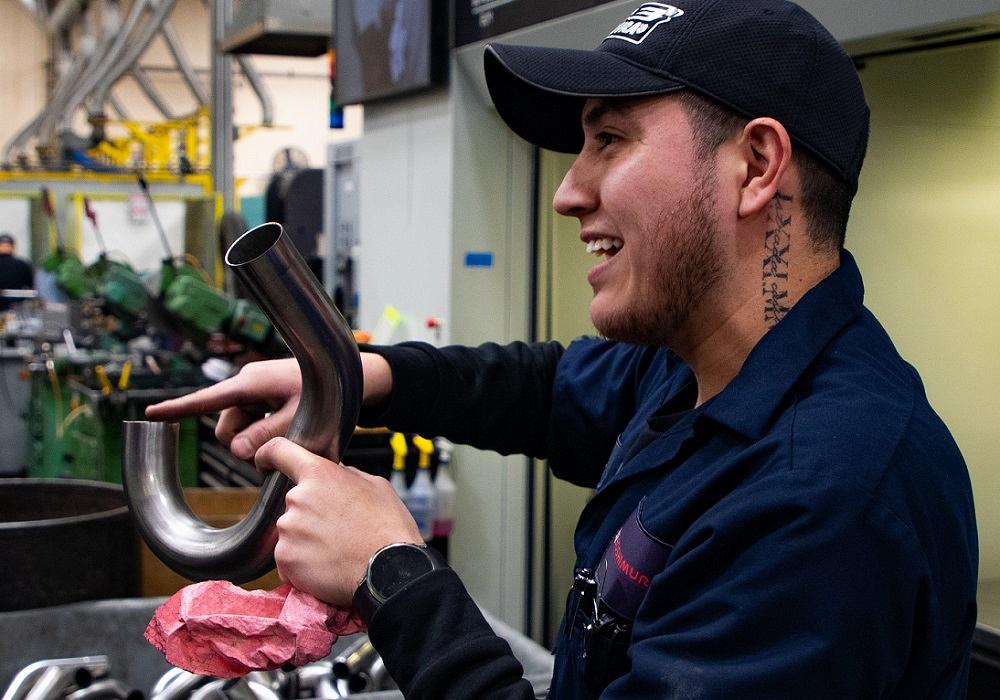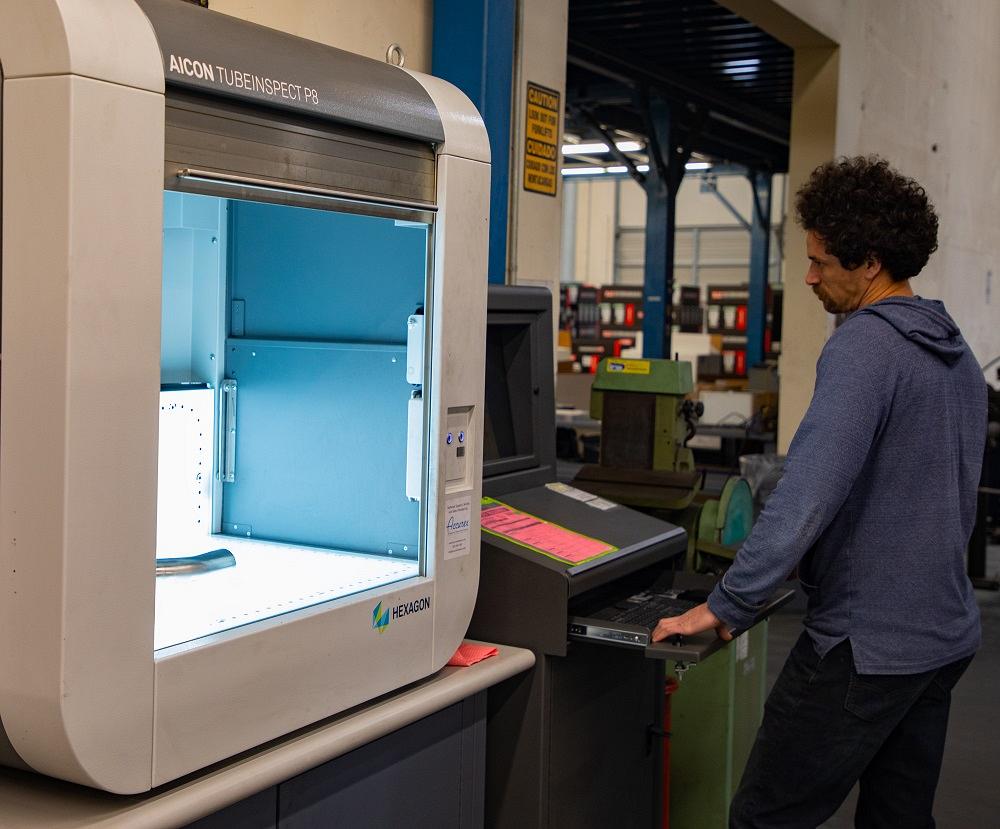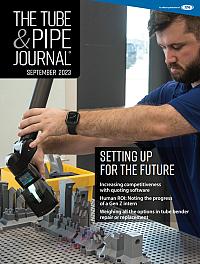Marketing Associate
- FMA
- The Fabricator
- FABTECH
- Canadian Metalworking
Categories
- Additive Manufacturing
- Aluminum Welding
- Arc Welding
- Assembly and Joining
- Automation and Robotics
- Bending and Forming
- Consumables
- Cutting and Weld Prep
- Electric Vehicles
- En Español
- Finishing
- Hydroforming
- Laser Cutting
- Laser Welding
- Machining
- Manufacturing Software
- Materials Handling
- Metals/Materials
- Oxyfuel Cutting
- Plasma Cutting
- Power Tools
- Punching and Other Holemaking
- Roll Forming
- Safety
- Sawing
- Shearing
- Shop Management
- Testing and Measuring
- Tube and Pipe Fabrication
- Tube and Pipe Production
- Waterjet Cutting
Industry Directory
Webcasts
Podcasts
FAB 40
Advertise
Subscribe
Account Login
Search
Inspection increases accuracy, speed of tube production
Yoshimura R&D uses visual system to improve products and process flow for worldwide motorcycle component customers
- By Patrick Bauer
- September 7, 2023
- Article
- Testing and Measuring

Adrian Estrada of Yoshimura R&D holds a tube up for a colleague at the company’s plant in Chino, Calif. The company has been making motorcycle parts for almost 70 years.
Walking through the doors of Yoshimura R&D of America Inc., you’re greeted by the sound of torches welding parts and saws cutting into metal.
These are the sounds of a busy plant fabricating a lot of tubing. Started in 1954, Yoshimura R&D of America, in Chino, Calif., manufactures exhaust systems and pipes for motorcycles for a worldwide customer base. One technology that has helped Yoshimura improve its operation is the Hexagon TubeInspect P8.2 from Accurex Measurement Inc..
The testing device was designed for automated inspection of bent tubing, brake lines, hydraulic lines, exhaust pipes, molded tubes, and wireforms. The system requires no fixtures or holding devices and provides data on whether the tube is within tolerance, the deviation from the control tube, and the bending corrections needed to make a correct part in seconds.
In addition, tubes and wireforms can be compared directly to CAD models or to a master part with direct feedback to tube bending machines. An operator can set up the TubeInspect to measure for values determined by the shop and know within seconds whether or not a part is good to go.
With operators sometimes in short supply, ease of use has become more attractive than ever, according to Paul Joss, director of sales and marketing for Accurex Measurement.
“Anyone can learn in five minutes how to measure tubes and be as good at it as someone who has been doing it for five years,” Joss said of the system. “This is because the operator has almost no influence on the measurement. This ease of use has become very important to our customers because of the labor shortages and turnover that manufacturers have been facing in recent years.”
Repeatability and Setup Times
At Yoshimura, the daily challenge of ensuring repeatability is compounded by the pressure to reduce setup times between part runs.
The company has a high-mix, low-volume process that can sometimes require more setup time than is optimal. Senior Mechanical Engineer Robert Flexen likes having a tool that helps mitigate some of that strain.
“The biggest difference has been speed and accuracy,” Flexen said. “Before, we would have to make laser-cut fixtures to measure each tube with. We would have to have them cut, then have the fixtures welded together. And then, the tube-bender technician would try his best to match tubes up to the fixture. With the TubeInspect, we eliminated that whole process.”
Being able to cut down on setup time for measuring the bent tubes has allowed the company not only to increase production but also to shift its focus to tightening the tolerances on its tubes. The company now can do the process faster and more accurately with the data that the machine gives tube bending technicians.

A welder works on a piece at Yoshimura R&D of America. The company makes exhaust systems and pipes for motorcycle customers worldwide.
“When we purchased the TubeInspect and Accurex set us up, they set us up with 60-thousandths and gave us a tighter 30-thousandths sheath for our bending,” Flexen said. “We found that with using the TubeInspect, we were able to reduce that all the way down to [a] five-thousandths sheath for basically every bend we do.
“We never had any empirical data on our tubes. We never knew if we were bending good or bad. The TubeInspect has allowed us to quantify our bends and drill down how accurate or inaccurate we have been.”
Joss pointed out that the system doesn’t just identify problems, but it also helps to increase users’ productivity by communicating solutions both to them and to their CNC tube benders.
“It closes the loop,” Joss said. “Traditional inspection tools check a part and give a pass or fail indication, but [they] leave it to the user to figure out how to fix it. [This system] basically says, ‘This tube is not in conformance, but don’t worry. Here is exactly what you need to do to fix it.’”
Downstream Reliability
Accuracy and speed aren’t the only parts of production the unit has improved, though.
Since purchasing the unit a few years ago, Yoshimura has acquired and implemented new equipment downstream in its production process because of the benefits the tool affords. One of those pieces is a BLM LT-Free Fiber laser cutter that has a 3D cutting head.
“Without the TubeInspect, we wouldn’t be able to confidently use this machine,” Flexen said of the laser cutter. “The TubeInspect allows for this automation process to take place, and that is due to the repeated ability to produce precisely bent tubes.”
Faster Training
Training new engineers and tube bending technicians can be a long process. However, the company has been able to shorten that significantly by helping technicians become more knowledgeable about the parts they are bending. By using the TubeInspect, the benders are able to see in real time the difference in tubes that are output based on their input to the bender. They simply have to take the tube from the bender and place it in the TubeInspect to get instant results.
Using this process has allowed Yoshimura to significantly drop the tolerance on its tubes from 30 thousandths sheath to 5 thousandths sheath.
“In regard to tube bending corrections, anything that is off, [the technician] can send it directly to the bender, or he can pick and choose which of those corrections to send back to the bender,” said Flexen. “Before, it was all up to the technician or the skill of the bender to really tune that bend and get it right. It has allowed new guys to come in and get running very quickly compared to before. I just had a guy come in and get up and running on his own in two to three months versus before, it was two to three years.”

Senior Mechanical Engineer Robert Flexen takes a second look at a tube in Yoshimura R&D’s TubeInspect P8.2.
The technician being able to send corrections directly from the TubeInspect to the bender itself is one of the many features that allows Yoshimura to not only be accurate but also efficient.
The system has proven itself versatile as its user base has expanded to many different industries, including HVAC, hydraulics, and heavy equipment, according to Joss.
“It started as just an optical gauge to check shape of a bent tube with square cut ends,” Joss said. “Over the years it has expanded to encompass many other needs, like tubes with end forms, beveled ends, [and] diameter changes. It has moved from a niche solution for aerospace and automotive industries to a mainstream solution across many industries.”
About the Author
About the Publication
Related Companies
subscribe now

The Tube and Pipe Journal became the first magazine dedicated to serving the metal tube and pipe industry in 1990. Today, it remains the only North American publication devoted to this industry, and it has become the most trusted source of information for tube and pipe professionals.
start your free subscription- Stay connected from anywhere

Easily access valuable industry resources now with full access to the digital edition of The Fabricator.

Easily access valuable industry resources now with full access to the digital edition of The Welder.

Easily access valuable industry resources now with full access to the digital edition of The Tube and Pipe Journal.
- Podcasting
- Podcast:
- The Fabricator Podcast
- Published:
- 04/16/2024
- Running Time:
- 63:29
In this episode of The Fabricator Podcast, Caleb Chamberlain, co-founder and CEO of OSH Cut, discusses his company’s...
- Trending Articles
Zekelman Industries to invest $120 million in Arkansas expansion

3D laser tube cutting system available in 3, 4, or 5 kW

Corrosion-inhibiting coating can be peeled off after use

Brushless copper tubing cutter adjusts to ODs up to 2-1/8 in.

HGG Profiling Equipment names area sales manager

- Industry Events
16th Annual Safety Conference
- April 30 - May 1, 2024
- Elgin,
Pipe and Tube Conference
- May 21 - 22, 2024
- Omaha, NE
World-Class Roll Forming Workshop
- June 5 - 6, 2024
- Louisville, KY
Advanced Laser Application Workshop
- June 25 - 27, 2024
- Novi, MI


























